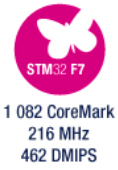
Introduction
Evaluation Boards
Tutorial
Important tips concerning the STM32F7
Interesting links
STM32F7xx is ARM® Cortex®-M7 processor brings high performance, Superscalar (2 instructions at 1 cycle), efficient digital signal processing to enable devices featuring superior embedded intelligence across the industrial, infrastructure and domestic sectors.
STM32F7 video presentation is here.
Thanks to their smart architecture with ST’s ART Accelerator™ and an L1 cache, STM32F7 MCUs deliver the full performance of the ARM® Cortex®-M7 core with code executed from either embedded Flash memory or an external memory, reaching 1082 CoreMark at 216 MHz.
Two product lines with up to 1 Mbyte of Flash memory are available; the STM32F745 line and the STM32F746/756 line with TFT controller and hardware cryptography acceleration.
Packages range from 100 to 216 pins with sizes as small as 4.5 x 5.5 mm.
Key characteristics of the Cortex M7 processor include:
- High performance 6 stage pipeline with dual-issue (it executes up to two instructions per clock cycle)
- A 64bit AXI bus interface as the system bus
- Optional instruction cache (4 to 64KB) and data cache (4 to 64KB), with optional ECC (Error Correction Code) support for each of the cache memories.
- Optional 64bit Instruction Tightly Coupled Memory (I -TCM), and optional dual 32bit Data TCM (D-TCM), with support for a custom ECC implementation for each of the TCM interfaces
- Optional low – latency AHB peripheral bus interface (referred as AHBP in ARM documents)
- Integrated Nested Vectored Interrupt Controller (NVIC) with 1 to 240 interrupts with 3 to 8bit programmable priority level registers
- Optional Memory Protection Unit (MPU) with 8 or 16 regions
- Optional Floating Point Unit (FPU) with support for single – and double – precision floating point instructions
- Support for sleep modes and various low power mplementation technologies
- Powerful debug features, with optional full instruction and data trace

Go on TOP
Evaluation Boards
- STM32F746G-DISCO
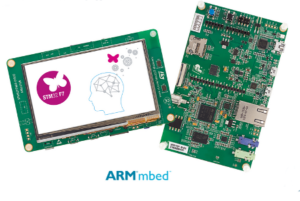
Key Features
STM32F746NGH6 microcontroller featuring 1 Mbytes of Flash memory and 340 Kbytes of RAM, in
BGA216 package
On-board ST-LINK/V2-1 supporting USB re-enumeration capability
USB functions: virtual COM port, mass storage, debug port
4.3-inch 480×272 color LCD-TFT with capacitive touch screen
Camera connector
SAI audio codec
Audio line in and line out jack
Stereo speaker outputs
Two ST MEMS microphones
SPDIF RCA input connector
Two pushbuttons (user and reset)
128-Mbit Quad-SPI Flash memory
128-Mbit SDRAM (64 Mbits accessible)
Connector for microSD card
RF-EEPROM daughterboard connector
USB OTG HS with Micro-AB connectors
USB OTG FS with Micro-AB connectors
Ethernet connector compliant with IEEE-802.3-2002
Five power supply options:
ST LINK/V2-1
USB FS connector
USB HS connector
VIN from Arduino connector
External 5 V from connector
Power supply output for external applications: 3.3 V or 5 V
Arduino Uno V3 connectors
Comprehensive free software including a variety of examples, part of STM32Cube package
– - Embedded Vision solution from SILICA
Based on STM32F746G-DISCO and TDnext CCD camera.

. - STM32756G-EVAL
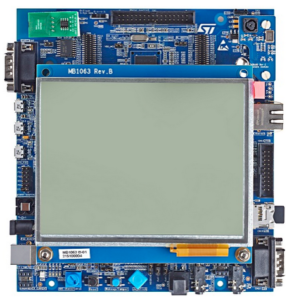
Key Features
STM32F756NGH6 microcontroller with 1 Mbyte Flash and 320+4 Kbytes RAM
Six 5 V power supply options:
Power jack
ST-LINK/V2-1 USB connector
User USB HS connector
User USB FS1 connector
User USB FS2 connector
Daughterboard
SAI Audio DAC, stereo audio jack which supports headset with microphone
Stereo digital microphone, audio jack connector used to connect external speakers
2 Gbytes (or more) SDMMC interface microSD card
RF-EEPROM on I2C compatible serial interface
RS-232 communication
IrDA transceiver
JTAG/SWD and ETM trace debug support, ST-LINK/V2-1 embedded
IEEE-802.3-2002 compliant Ethernet connector
Camera module
8Mx32bit SDRAM, 1Mx16bit SRAM & 8Mx16bit Nor Flash
512 Mbits QuadSPI Nor Flash
5.7 inch 640×480 pixel TFT color LCD with capacitive touch panel
Joystick with 4-direction control and selector.
Reset, WakeUp/Tamper or key button
4 color user LEDs
Extension connectors and memory connectors for daughterboard or wrapping board
USB OTG HS and FS with Micro-AB connectors
RTC with backup battery
CAN 2.0A/B compliant connection
Potentiometer
Motor control connector - A complete list of the evaboards is here.
Go on TOP
Tutorial
- STM32F7 training courses available online, see here
- Some important tips concerning the STM32F7 (Cortex M7).
- STM32F7-Training 09/2015 – PoliTO (all documentations and Hands-On are free – we used the KEIL IDE)
- STM32F7-Training 06/2015 (we used the IAR IDE)
This training cover this topics
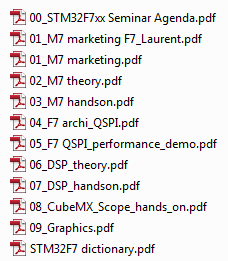
IMPORTANT NOTE
At the moment, the STM32F7-Training 06/2015 shall be issued only to SILICA customers.
If you are SILICA customer send me an email and ask me:
STM32F7-Training 06/2015
please specify also your City, Country and your contact in SILICA.
If you are STM customer please contact directly your local office of STM.
. - Some important AN:
Go on TOP
Important tips concerning the STM32F7
M7 Core
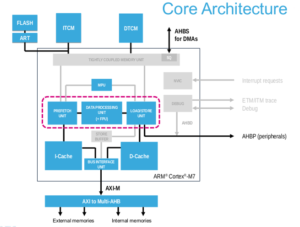
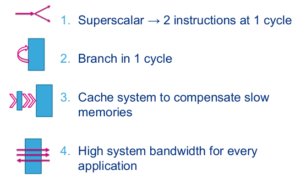
.
The instruction set of M7 are the same of M4 (see below), but a big difference is a High performance 6 stage pipeline with dual-issue (it executes up to two instructions per clock cycle).

M7 is a superscalar MCU, this means that it has the possibility to execute two instruction every clock cycle.
In other word means that Cortex M7 fetch from flash at 64bit.
But for reach this performance is very important that the compiler is a clever compiler, this because M7 has the possibility to execute (in the same time) one of this instructions; see the red box below.
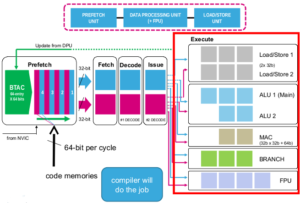
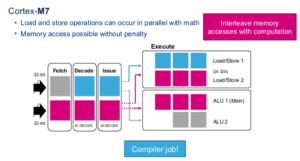
If the compiler write on two sequentially 32bit of flash, two load instructions, the M7 execute the first load and at the next clock cycle the second load… you have lost the possibility to execute two instruction every machine cycle.
See the MPU instructions, in the Hands-On sections.
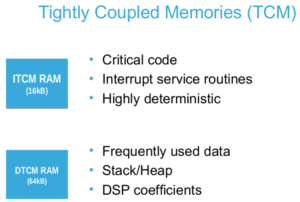
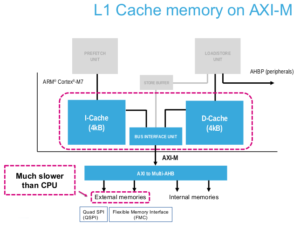
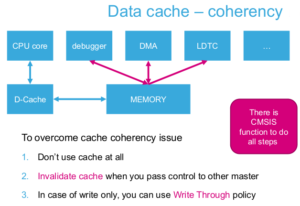
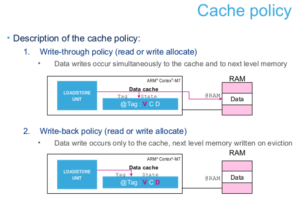
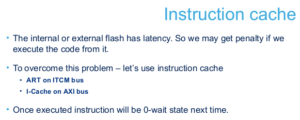
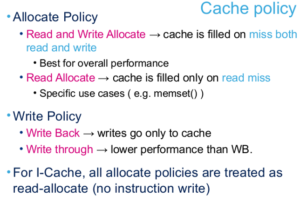
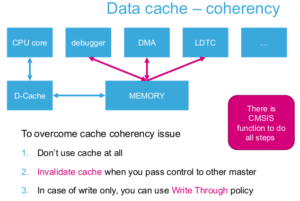

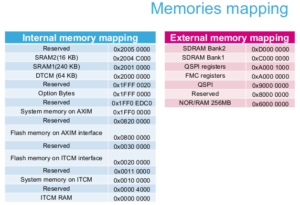
There are some examples concerning Cache, ITCM, DTCM, etc, in the Hands-On of this training.
Go on TOP
Interesting links
- STM32 F7 Series – The smartest STM32 ever: World’s 1st ARM® Cortex® -M7 based 32-bit MCU (on YouTube)
- ARM Cortex-M7: Digital Signal Processing Drives Family Evolution
- ARM gives Internet of Things a piece of its mind – the Cortex-M7
- STMicro, ARM do a double whammy with new Cortex-M7 core
- Cortex-M7 Launches: Embedded, IoT and Wearables
Go on TOP
